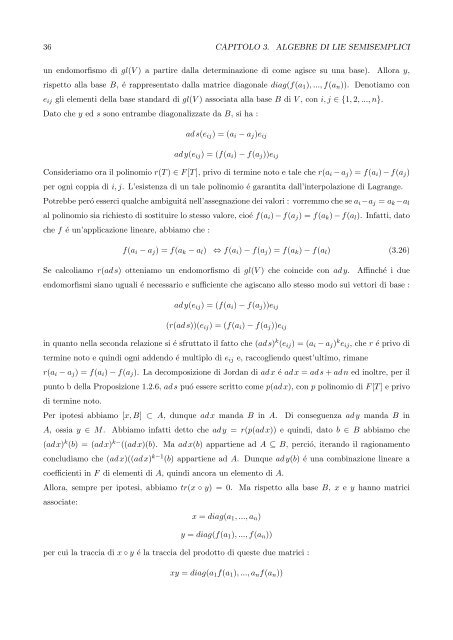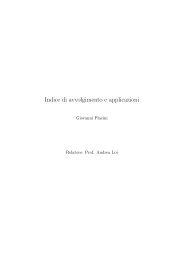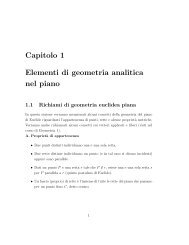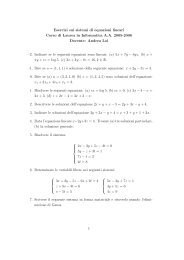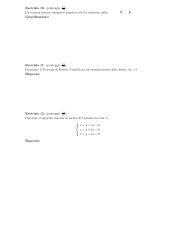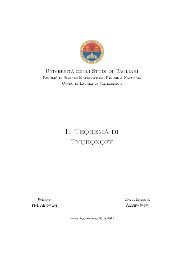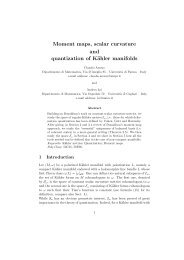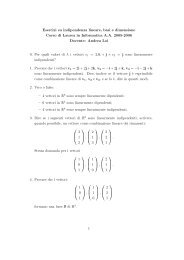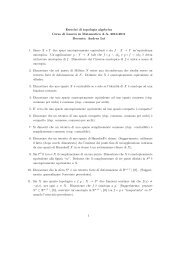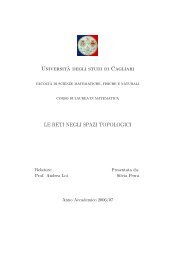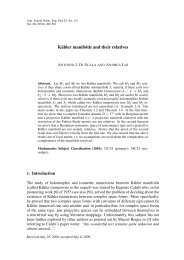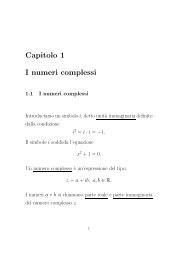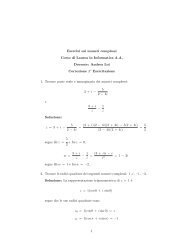Algebre di Lie semisemplici, sistemi di radici e loro classificazione
Algebre di Lie semisemplici, sistemi di radici e loro classificazione
Algebre di Lie semisemplici, sistemi di radici e loro classificazione
You also want an ePaper? Increase the reach of your titles
YUMPU automatically turns print PDFs into web optimized ePapers that Google loves.
36 CAPITOLO 3. ALGEBRE DI LIE SEMISEMPLICI<br />
un endomorfismo <strong>di</strong> gl(V ) a partire dalla determinazione <strong>di</strong> come agisce su una base). Allora y,<br />
rispetto alla base B, é rappresentato dalla matrice <strong>di</strong>agonale <strong>di</strong>ag(f(a1), ..., f(an)). Denotiamo con<br />
eij gli elementi della base standard <strong>di</strong> gl(V ) associata alla base B <strong>di</strong> V , con i, j ∈ {1, 2, ..., n}.<br />
Dato che y ed s sono entrambe <strong>di</strong>agonalizzate da B, si ha :<br />
ad s(eij) = (ai − aj)eij<br />
ad y(eij) = (f(ai) − f(aj))eij<br />
Consideriamo ora il polinomio r(T ) ∈ F [T ], privo <strong>di</strong> termine noto e tale che r(ai − aj) = f(ai) − f(aj)<br />
per ogni coppia <strong>di</strong> i, j. L’esistenza <strong>di</strong> un tale polinomio é garantita dall’interpolazione <strong>di</strong> Lagrange.<br />
Potrebbe peró esserci qualche ambiguitá nell’assegnazione dei valori : vorremmo che se ai−aj = ak −al<br />
al polinomio sia richiesto <strong>di</strong> sostituire lo stesso valore, cioé f(ai) − f(aj) = f(ak) − f(al). Infatti, dato<br />
che f é un’applicazione lineare, abbiamo che :<br />
f(ai − aj) = f(ak − al) ⇔ f(ai) − f(aj) = f(ak) − f(al) (3.26)<br />
Se calcoliamo r(ad s) otteniamo un endomorfismo <strong>di</strong> gl(V ) che coincide con ad y. Affinché i due<br />
endomorfismi siano uguali é necessario e sufficiente che agiscano allo stesso modo sui vettori <strong>di</strong> base :<br />
ad y(eij) = (f(ai) − f(aj))eij<br />
(r(ad s))(eij) = (f(ai) − f(aj))eij<br />
in quanto nella seconda relazione si é sfruttato il fatto che (ad s) k (eij) = (ai − aj) k eij, che r é privo <strong>di</strong><br />
termine noto e quin<strong>di</strong> ogni addendo é multiplo <strong>di</strong> eij e, raccogliendo quest’ultimo, rimane<br />
r(ai − aj) = f(ai) − f(aj). La decomposizione <strong>di</strong> Jordan <strong>di</strong> ad x é ad x = ad s + ad n ed inoltre, per il<br />
punto b della Proposizione 1.2.6, ad s puó essere scritto come p(ad x), con p polinomio <strong>di</strong> F [T ] e privo<br />
<strong>di</strong> termine noto.<br />
Per ipotesi abbiamo [x, B] ⊂ A, dunque ad x manda B in A. Di conseguenza ad y manda B in<br />
A, ossia y ∈ M. Abbiamo infatti detto che ad y = r(p(ad x)) e quin<strong>di</strong>, dato b ∈ B abbiamo che<br />
(ad x) k (b) = (ad x) k− ((ad x)(b). Ma ad x(b) appartiene ad A ⊆ B, perció, iterando il ragionamento<br />
conclu<strong>di</strong>amo che (ad x)((ad x) k−1 (b) appartiene ad A. Dunque ad y(b) é una combinazione lineare a<br />
coefficienti in F <strong>di</strong> elementi <strong>di</strong> A, quin<strong>di</strong> ancora un elemento <strong>di</strong> A.<br />
Allora, sempre per ipotesi, abbiamo tr(x ◦ y) = 0. Ma rispetto alla base B, x e y hanno matrici<br />
associate:<br />
x = <strong>di</strong>ag(a1, ..., an)<br />
y = <strong>di</strong>ag(f(a1), ..., f(an))<br />
per cui la traccia <strong>di</strong> x ◦ y é la traccia del prodotto <strong>di</strong> queste due matrici :<br />
xy = <strong>di</strong>ag(a1f(a1), ..., anf(an))


